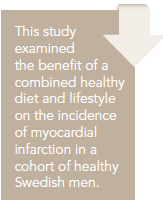Medication-Free Strategies Can Prevent Coronary Heart Disease
Drug therapy is recognized as an effective way to lower lipids and control hypertension, and for its effect on reducing the incidence of myocardial infarction. However, the impact of personal habits, such as eating, drinking, smoking, and exercise, on the incidence of coronary heart disease without reliance on prescription medications and their potential side effects may be less well established.

Harry E. Davis II, MD, MACP
Review
Akesson A, Larsson SC, Discacciati A, Wolk A. Low-risk diet and lifestyle habits in the primary prevention of myocardial infarction in men: a population-based prospective cohort study. J Am Coll Cardiol. 2014;64:1299-1306.
Drug therapy is recognized as an effective way to lower lipids and control hypertension, and for its effect on reducing the incidence of myocardial infarction (MI).1,2 However, the impact of personal habits, such as eating, drinking, smoking, and exercise, on the incidence of coronary heart disease (CHD) without reliance on prescription medications and their potential side effects may be less well established.
Study Details

Akesson et al looked at this question by examining a large, population-based prospective cohort of healthy Swedish men to determine if specific preventive efforts could have a beneficial effect on the incidence of MI.3 Their methodology called for sending questionnaires to all males aged 45 to 79 years residing in 2 counties in central Sweden. With a response rate of 49%, they then excluded men with a history of cancer, ischemic heart disease, stroke, hypertension, high cholesterol, diabetes, and those with extremes of caloric intake. This left 20,721 men for analysis. They followed this cohort until the date of the first event of MI, death, or end of the follow-up period.
Diet was assessed using a self-administered food frequency questionnaire (FFQ) on 96 commonly eaten foods. A healthy or low-risk diet was defined as including foods with a beneficial effect on cardiovascular health, such as fruits, vegetables, legumes, nuts, reduced-fat dairy products, whole grains, and fish. The investigators assigned a Recommended Food Score of 1 for more than 1 serving per week of any of 3 reduced-fat dairy products, crisp bread, and whole grain bread, and for consuming the remaining food items at least 1 to 3 times per month, for a maximum of 25 points. They considered those who scored in the highest quintile (23 to 25) as having a very healthy, low-risk diet. This division of the results was due to the finding that only the top quintile was associated with a statistically significant decreased risk of MI.
Conversely, a high-risk diet was identified using a non-Recommended Food Score based on 21 food items including red and processed meat, fried potatoes, solid fats, full-fat cheese, white bread, refined cereals, and various sweet foods. This score was then used to adjust risk.
Lifestyle was examined using questionnaire data regarding alcohol consumption, smoking, physical activity, and abdominal adiposity. Alcohol consumption of 10 to 30 g daily was considered low risk. Study subjects who never smoked and those who had stopped smoking at least? ≥20 years ago were classified as nonsmokers. Physical activity was considered low risk in men who walked or cycled for at least 40 minutes per day and exercised at least 1 hour per week. A waist circumference less than 95 cm was considered low risk. The investigators then analyzed the data to estimate the percentage of MI cases that could potentially be prevented if men adhered to the low-risk practices.
Baseline characteristics of the cohort showed men with a low-risk diet were more likely to have a higher level of education, and to not smoke, and were less likely to live alone. During a mean of 11 years of follow-up, 1361 cases of primary MI were reported in the cohort using the Swedish National Inpatient and Cause of Death registers. Compared with men in the high-risk group, each lifestyle factor was independently associated with an inverse risk of coronary events in the low-risk group. A risk reduction of 18% was seen for the healthy diet, 11% for moderate alcohol consumption, 36% for no smoking, 3% for being physically active, and 12% for having a low abdominal circumference.
Further analysis of the data revealed that 8.7% of the men had combined a low-risk diet with moderate alcohol consumption. This group consumed a daily mean of 5 servings of vegetables and fruits and 4 servings of whole grains, and a weekly consumption of 2.2 servings of fish. Their combined low-risk behavior was associated with a 35% reduction in the risk of MI.
Finally, the comprehensive low-risk profile that included all 5 low-risk factors was associated with an 86% lower risk of MI compared with the high-risk group with no low-risk factors. The absolute rate difference between men having no low-risk factors and those having all 5 low-risk factors was 848 cases per 100,000 person-years. Unfortunately, this low-risk profile was fulfilled by only 1% of the study population.
Based on their data analysis, the authors estimated that 79% of the burden of disease in this group of healthy men without hypertension, high cholesterol, or diabetes could be reduced by adherence to a combination of the low-risk diet, moderate alcohol consumption, and the 3 low-risk behaviors. Thus, combining a healthy diet, moderate alcohol consumption, no smoking, being physically active, and maintaining a healthy weight could potentially prevent 4 of 5 MIs in the study population.
CommentaryA healthy diet and lifestyle and the potential for greatly reduced CHD risk
Akesson et al provide impressive evidence for a lowered risk of CHD with a low-risk lifestyle in a specific population of Swedish males. Based on their analysis of this data, they suggest that the combination of low-risk behaviors that include a healthy diet, moderated alcohol consumption, no smoking, being physically active, and maintaining a healthy weight can prevent a majority of MI events in men.
As they discuss, the potential contribution of a low-risk lifestyle to the reduction of the burden of disease is great. The logical consequence of this study is their call for the development of “population-based strategies to promote healthy behaviors that can be introduced early in life and maintained throughout the life span.”
The idea that diet and lifestyle may be important factors affecting health and well-being is not new. As was pointed out in a previous review,4 the Human Population Laboratory of the California State Department of Health Services in Berkeley, California, initiated a study of common health practices and their potential for a positive effect on health in 1965.5 Later referred to as the “Alameda 7,” they found 7 health habits to be associated with physical health status and mortality. These habits were: having never smoked, drinking fewer than 2 drinks at one sitting, sleeping 7 to 8 hours a night, exercising, maintaining a desirable weight, avoiding snacks, and eating breakfast regularly. An increased risk of death was associated with being male, smoking, having little physical activity, being overweight or underweight, and not regularly eating breakfast.6
More recently, Lopez-Garcia et al7 looked at men and women with cardiovascular disease and found adherence to a Mediterranean-style dietary pattern was associated with lower all-cause mortality. Simply increasing the daily servings of fruit or green leafy vegetables has been shown to be associated with a significantly reduced risk of type 2 diabetes.8
The study by Akesson et al has again confirmed the likelihood that diet and lifestyle are very important. It contributes to the growing literature that supports the reduction of morbidity and mortality through adopting healthy dietary and lifestyle patterns. Their call for programs targeting efforts to increase adherence to low-risk behaviors is compelling; however, the reality that only 1% of their study population actually attained optimal lifestyle characteristics cannot be overlooked. Similarly, Go et al found that less than 1% of Americans met at least 4 of 5 healthy dietary goals in 2009 to 2010.9
In an era when physician effectiveness may be based on patient outcomes,10 physicians must pursue the development of patient behavior that increases the likelihood that patients will make healthier choices. This may well be an enormous challenge. As was so well noted many centuries ago, “The gate is narrow and the road is hard that leads to life, and there are few who find it.”11
References
1. Baigent C, Keech A, Kearney PM, et al. Efficacy and safety of cholesterol-lowering treatment: prospective meta-analysis of data from 90,056 participants in 14 randomised trials of statins. Lancet. 2005;366:1267-1278.
2. Law MR, Morris JK, Wald NJ. Use of blood pressure lowering drugs in the prevention of cardiovascular disease: meta-analysis of 147 randomised trials in the context of expectations from prospective epidemiological studies. BMJ. 2009;338:1665
3. Akesson A, Larsson SC, Discacciati A, Wolk A. Low-risk diet and lifestyle habits in the primary prevention of myocardial infarction in men: a population-based prospective cohort study. J Am Coll Cardiol. 2014;64:1299-1306.
4. Davis HE. Is there something to be said for eating breakfast daily? Cardiology Rev. 2013;29. HCPLive website. www.hcplive.com/publications/cardiology-review-online/2013/October2013/Is-There-Something-to-Be-Said-for-Eating-Breakfast-Daily.
5. Belloc NB, Breslow L. Relationship of physical health status and health practices. Prev Med. 1972;1:409-421.
6. Kaplan GA, Seeman TE, et al. Mortality among the elderly in the Alameda County study: behavioral and demographic risk factors. Am J Public Health. 1987;77:307-312.
7. Lopez-Garcia E, Rodriguez-Artalejo F, Li TY, et al. The Mediterranean-style dietary pattern and mortality among men and women with cardiovascular disease. Am J Clin Nutr. 2014;99:172-180.
8. Li M, Fan Y, Zhang X, et al. Fruit and vegetable intake and risk of type 2 diabetes mellitus: meta-analysis of prospective cohort studies. BMJ Open. 2014;4:e005497.
9. Go AS, Mozaffarian D, Roger VL, et al. Executive summary: heart disease and stroke statistics-2014 update: a report from the American Heart Association. Circulation. 2014;129:399-410.
10. Hershberger PJ, Bricker DA. Who determines physician effectiveness? JAMA. Published online October 13, 2014. doi:10.1001/jama.2014.13304
11. Matthew 7:14. In: Metzger BM, Murphy RE, eds. The New Oxford Annotated Bible with the Apocryphal/Deuterocanonical Books, New Revised Standard Version. NY: Oxford University Press; 1994.
About the Author
Harry E. Davis II, MD, MACP, is Associate Professor of Medicine and Vice Chair for Education in the Department of Internal Medicine, Texas Tech University Medical Sciences Center, El Paso, Texas. Dr. Davis received his medical degree from West Virginia University in Morgantown, West Virginia, and did his internal medicine residency at Philadelphia General Hospital in Philadelphia, Pennsylvania, and Letterman Army Medical Center in San Francisco, California. He has practiced medicine with the US Army in many capacities, including Chief of Emergency Medicine in Fort Lewis, Washington, Division Surgeon in the 1st Infantry Division, Fort Riley, Kansas, and as Commander of the Field Hospital/Chief Medical Officer with the UN Forces in Port-au-Prince, Haiti. Dr Davis has received numerous honors and awards for service and teaching.
